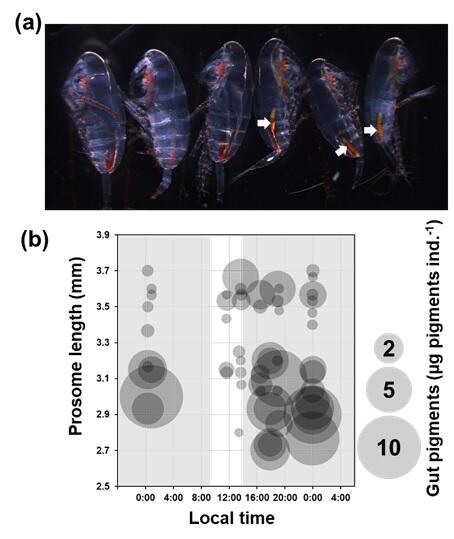A research group led by Assistant Professor Kohei Matsuno, Associate Professor Atsushi Yamaguchi and Associate Professor Yasuhiro Ando of the Faculty/Graduate School of Fisheries Science at Hokkaido University announced their discovery that the large copepod Calanus glacialis/marshallae, the most dominant zooplankton species in the Pacific Arctic Ocean (where warming effects have been most noticeable recently), has undergone changes in its size, population structure, and growth and feeding rates in response to geographic environmental changes. The discovery followed ecological surveys conducted by the researchers over a wide area of the Pacific Arctic Ocean, ranging from the continental shelf region to the ocean basin region. Their findings are expected to improve the accuracy in predicting the future of the Arctic marine ecosystem. The findings were published in the September 20, 2023 issue of the international journal Frontiers in Marine Science.

Provided by Hokkaido University
The large copepod Calanus glacialis/marshallae is the dominant zooplankton biomass in the shelf areas from the Bering Sea to the Arctic Ocean and an important food source for fish and other top predators. In recent years, sea ice melting, speculated to be caused by global warming, has increased significantly in the Arctic Ocean. Clarifying the response to this environmental change is important for determining the structure of lower-order marine ecosystems.
In October 2019, the research group collected zooplankton samples, using vertical tows and plankton nets, from various fixed points in the Pacific Arctic Ocean either directly above the seafloor or at 150 m below the surface. The fresh Calanus glacialis/marshallae samples were grouped on the vessel, and those intended for population structure and body length (cephalothorax length) analyses were fixed in formalin. Some of the fresh samples were used for the measurement of the gut pigment content (an indicator of feeding intensity) using a fluorometer. Samples were also frozen and taken to the terrestrial laboratory for fatty acid analysis to evaluate the taxonomy of the prey species.
In the terrestrial laboratory, Individuals at each developmental stage were counted under a stereomicroscope and the body length (cephalothorax length) was measured. Fatty acids were analyzed using gas chromatography. The results indicated that the population structure of Calanus glacialis/marshallae varied widely geographically, with faster growth in the southern continental shelf region and slower growth in the northern ocean basin region. Younger individuals in the ocean basin region were more abundant than previously reported, suggesting the extension of their reproduction phase into the summer months.
With regards to the fatty acid composition, individuals from the northern continental shelf region contained a high concentration of docosahexaenoic acid, which was derived from dinoflagellates. This suggests that the species can alter its feeding habits depending on the marine region.
In the Arctic Ocean, where the environment is changing rapidly, the dominant zooplankton species Calanus glacialis/marshallae could alter its feeding and reproductive strategies in response to environmental changes. This high flexibility observed in the organisms will likely allow them to survive future climate changes. The researchers hope that clarifying the ecology and life history of marine organisms will result in a more accurate understanding of the effects of climate change on marine ecosystems, thereby leading to the future conservation of such ecosystems and sustainable use of marine resources.
Matsuno said, "It is difficult to go to the field on a research vessel, but when you do go, you notice things and feel changes. The study began when I was sorting zooplankton under a microscope on the vessel and happened to notice that some of the individuals were differently sized. In the Arctic Ocean, we have seen changes in several marine organisms owing to climate change, and we believe that it is important to further investigate the adaptability of the organisms to environmental changes."
Journal Information
Publication: Frontiers in Marine Science
Title: Geographic variation in population structure and grazing features of Calanus glacialis/marshallae in the Pacific Arctic Ocean
DOI: 10.3389/fmars.2023.1168015
This article has been translated by JST with permission from The Science News Ltd. (https://sci-news.co.jp/). Unauthorized reproduction of the article and photographs is prohibited.




